2017成人口服营养补充专家共识解读
- 格式:pptx
- 大小:3.76 MB
- 文档页数:48
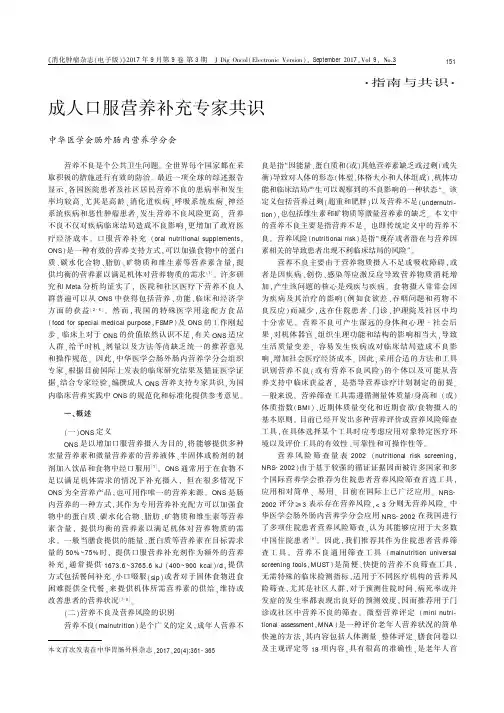
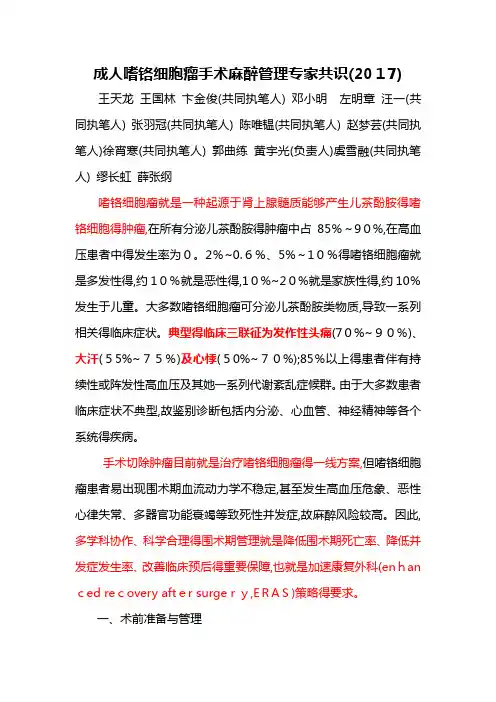
成人嗜铬细胞瘤手术麻醉管理专家共识(2017)王天龙王国林卞金俊(共同执笔人) 邓小明左明章汪一(共同执笔人) 张羽冠(共同执笔人) 陈唯韫(共同执笔人) 赵梦芸(共同执笔人)徐宵寒(共同执笔人) 郭曲练黄宇光(负责人)虞雪融(共同执笔人) 缪长虹薛张纲嗜铬细胞瘤就是一种起源于肾上腺髓质能够产生儿茶酚胺得嗜铬细胞得肿瘤,在所有分泌儿茶酚胺得肿瘤中占85%~90%,在高血压患者中得发生率为0。
2%~0.6%、5%~10%得嗜铬细胞瘤就是多发性得,约10%就是恶性得,10%~20%就是家族性得,约10%发生于儿童。
大多数嗜铬细胞瘤可分泌儿茶酚胺类物质,导致一系列相关得临床症状。
典型得临床三联征为发作性头痛(70%~90%)、大汗(55%~75%)及心悸(50%~70%);85%以上得患者伴有持续性或阵发性高血压及其她一系列代谢紊乱症候群。
由于大多数患者临床症状不典型,故鉴别诊断包括内分泌、心血管、神经精神等各个系统得疾病。
手术切除肿瘤目前就是治疗嗜铬细胞瘤得一线方案,但嗜铬细胞瘤患者易出现围术期血流动力学不稳定,甚至发生高血压危象、恶性心律失常、多器官功能衰竭等致死性并发症,故麻醉风险较高。
因此,多学科协作、科学合理得围术期管理就是降低围术期死亡率、降低并发症发生率、改善临床预后得重要保障,也就是加速康复外科(enhan ced recovery after surgery,ERAS)策略得要求。
一、术前准备与管理(一)术前检查1、实验室检查(1)常规检查:血细胞比容(hemotocrit,Hct)与红细胞沉降速率有助于评估血液浓缩情况,反映血管内容量;血糖与糖耐量检测可反映糖代谢情况。
(2)儿茶酚胺相关检查:首选24h尿甲氧基肾上腺素类物质(m etanephrines,MNs) 或血浆游离MNs测定,MNs为儿茶酚胺在肿瘤中得代谢产物;其次为血或尿儿茶酚胺测定,其相关检查有助于明确肿瘤分泌儿茶酚胺得类型,对后续儿茶酚胺补充治疗有重要指导意义、2、影像学检查(1)胸腹腔与盆腔CT或MRI有助于评估肿瘤大小、就是否浸润,及其与周围结构关系。


参考文献[1]Cederholm T, Barazzoni R, Austin P, et al. ESPEN guidelines on definitions andterminology of clinical nutrition[J]. Clin Nutr, 2016, In press.DOI:10.1016/j.clnu.2016.09.004.[2]Elia M, Normand C, Laviano A, et al. A systematic review of the cost and costeffectiveness of using standard oral nutritional supplements in community and care home settings[J]. Clin Nutr, 2016,35(1):125-137. DOI:10.1016/j.clnu.2015.07.012.[3]Parsons EL, Stratton RJ, Cawood AL, et al. Oral nutritional supplements in arandomised trial are more effective than dietary advice at improving quality of life in malnourished care home residents[J]. Clin Nutr, 2016, In press.DOI:10.1016/j.clnu.2016.01.002.[4]Deutz NE, Matheson EM, Matarese LE, et al. Readmission and mortality inmalnourished, older, hospitalized adults treated with a specialized oral nutritional supplement: A randomized clinical trial[J]. Clin Nutr, 2016,35(1):18-26. DOI:10.1016/j.clnu.2015.12.010.[5]Cramer JT, Cruz-Jentoft AJ, Landi F, et al. Impacts of High-Protein OralNutritional Supplements Among Malnourished Men and Women with Sarcopenia:A Multicenter, Randomized, Double-Blinded, Controlled Trial[J]. J Am Med DirAssoc, 2016,17(11):1044-1055. DOI: 10.1016/j.jamda.2016.08.009.[6]Elia M, Normand C, Norman K, et al. A systematic review of the cost and costeffectiveness of using standard oral nutritional supplements in the hospital setting[J]. Clin Nutr, 2016,35(2):370-380. DOI: 10.1016/j.clnu.2015.05.010. [7]Jensen GL. Oral nutritional supplementation[J]. Am J Manag Care,2013,19(2):119-120.[8]Stratton RJ, Elia M. Encouraging appropriate, evidence-based use of oralnutritional supplements[J]. Proc Nutr Soc, 2010,69(4):477-487. DOI:10.1017/S0029665110001977.[9]蒋朱明,陈伟,朱赛楠,等. 中国东、中、西部大城市三甲医院营养不良(不足)、营养风险发生率及营养支持应用状况调查[J].中国临床营养杂志,2008,16(6):335-337. DOI: 10.3881/j.issn.1008-5882.2008.06.002.[10]S treicher M, Themessl-Huber M, Schindler K, et al. Who receives oral nutritionalsupplements in nursing homes? Results from the nutritionDay project [J]. ClinNutr, 2016, In press. DOI:10.1016/j.clnu.2016.09.005.[11]D upuy C, de Souto Barreto P, Ghisolfi A, et al. Indicators of oral nutritionalsupplements prescription in nursing home residents: A cross-sectional study[J].Clin Nutr, 2016,35(5):1047-1052. DOI: 10.1016/j.clnu.2015.07.015.[12]G azzotti C, Arnaud-Battandier F, Parello M, et al. Prevention of malnutrition inolder people during and after hospitalisation: results from a randomised controlled clinical trial[J]. Age Ageing, 2003,32(3):321-325.[13]Z hong Y, Cohen JT, Goates S, et al. The Cost-Effectiveness of Oral NutritionSupplementation for Malnourished Older Hospital Patients[J]. Appl Health Econ Health Policy, 2017,15(1):75-83. DOI: 10.1007/s40258-016-0269-7.[14]N eelemaat F, Bosmans JE, Thijs A, et al. Oral nutritional support in malnourishedelderly decreases functional limitations with no extra costs[J]. Clin Nutr, 2012,31(2):183-190. DOI: 10.1016/j.clnu.2011.10.009.[15]A bizanda P, López MD, García VP, et al. Effects of an Oral NutritionalSupplementation Plus Physical Exercise Intervention on the Physical Function, Nutritional Status, and Quality of Life in Frail Institutionalized Older Adults: The ACTIVNES Study[J]. J Am Med Dir Assoc, 2015,16(5):439.e9-439.e16. DOI:10.1016/j.jamda.2015.02.005.[16]W outers-Wesseling W, V an Hooijdonk C, Wagenaar L, et al. The effect of a liquidnutrition supplement on body composition and physical functioning in elderly people[J]. Clin Nutr, 2003,22(4):371-377.[17]A bizanda P, Sinclair A, Barcons N, et al. Costs of Malnutrition inInstitutionalized and Community-Dwelling Older Adults: A Systematic Review[J].J Am Med Dir Assoc, 2016,17(1):17-23. DOI: 10.1016/j.jamda.2015.07.005. [18]H atao F, Chen KY, Wu JM, et al. Randomized controlled clinical trial assessingthe effects of oral nutritional supplements in postoperative gastric cancer patients [J]. Langenbecks Arch Surg, 2016, In press. DOI:10.1007/s00423-016-1527-8. [19]A venell A, Smith TO, Curtain JP, et al. Nutritional supplementation for hipfracture aftercare in older people[J]. Cochrane Database Syst Rev, 2016,11:CD001880. DOI: 10.1002/14651858.CD001880.pub6.[20]M oya P, Soriano-Irigaray L, Ramirez JM, et al. Perioperative Standard OralNutrition Supplements Versus Immunonutrition in Patients Undergoing Colorectal Resection in an Enhanced Recovery (ERAS) Protocol: A Multicenter Randomized Clinical Trial (SONVI Study)[J]. Medicine (Baltimore),2016,95(21):e3704. DOI: 10.1097/MD.0000000000003704.[21]P hilipson TJ, Snider JT, Lakdawalla DN, et al. Impact of oral nutritionalsupplementation on hospital outcomes[J]. Am J Manag Care, 2013,19(2):121-128.[22]L iu M, Yang J, Yu X, et al. The role of perioperative oral nutritionalsupplementation in elderly patients after hip surgery[J]. Clin Interv Aging, 2015,10:849-858. DOI: 10.2147/CIA.S74951.[23]B urden ST, Gibson DJ, Lal S, et al. Pre-operative oral nutritional supplementationwith dietary advice versus dietary advice alone in weight-losing patients with colorectal cancer: single-blind randomized controlled trial [J]. J Cachexia Sarcopenia Muscle, 2017, In press. DOI:10.1002/jcsm.12170.[24]I mamura H, Nishikawa K, Kishi K, et al. Effects of an Oral Elemental NutritionalSupplement on Post-gastrectomy Body Weight Loss in Gastric Cancer Patients: A Randomized Controlled Clinical Trial[J]. Ann Surg Oncol, 2016,23(9):2928-2935.DOI: 10.1245/s10434-016-5221-4.[25]C awood AL, Elia M, Stratton RJ. Systematic review and meta-analysis of theeffects of high protein oral nutritional supplements[J]. Ageing Res Rev, 2012,11(2):278-296. DOI: 10.1016/j.arr.2011.12.008.[26]中华医学会肠外肠内营养学分会. 成人围手术期营养支持指南[J].中华外科杂志,2016,54(9):641-657. DOI: 10.3760/cma.j.issn.0529-5815.2016.09.001. [27]A rends J, Bachmann P, Baracos V, et al. ESPEN guidelines on nutrition in cancerpatients [J]. Clin Nutr, 2016, In press. DOI:10.1016/j.clnu.2016.07.015.[28]V olkert D, Berner YN, Berry E, et al. ESPEN Guidelines on Enteral Nutrition:Geriatrics[J]. Clin Nutr, 2006,25(2):330-360. DOI: 10.1016/j.clnu.2006.01.012. [29]S tange I, Bartram M, Liao Y, et al. Effects of a low-volume, nutrient- andenergy-dense oral nutritional supplement on nutritional and functional status: a randomized, controlled trial in nursing home residents[J]. J Am Med Dir Assoc, 2013,14(8):628.e1-e8. DOI: 10.1016/j.jamda.2013.05.011.[30]I Jpma I, Renken RJ, Ter HGJ, et al. The palatability of oral nutritionalsupplements: before, during, and after chemotherapy[J]. Support Care Cancer, 2016,24(10):4301-4308. DOI: 10.1007/s00520-016-3263-6.[31]R elph WL. Addressing the nutritional needs of older patients[J]. Nurs OlderPeople, 2016,28(3):16-19. DOI: 10.7748/nop.28.3.16.s22.[32]G uyonnet S, Rolland Y. Screening for Malnutrition in Older People[J]. ClinGeriatr Med, 2015,31(3):429-437. DOI: 10.1016/j.cger.2015.04.009.[33]A garwal E, Miller M, Yaxley A, et al. Malnutrition in the elderly: a narrativereview[J]. Maturitas, 2013,76(4):296-302. DOI: 10.1016/j.maturitas.2013.07.013.[34]M ilne AC, Potter J, Vivanti A, et al. Protein and energy supplementation inelderly people at risk from malnutrition[J]. Cochrane Database Syst Rev, 2009,(2):CD003288. DOI: 10.1002/14651858.CD003288.pub3.[35]G ariballa S, Forster S, Walters S, et al. A randomized, double-blind,placebo-controlled trial of nutritional supplementation during acute illness[J]. Am J Med, 2006,119(8):693-699. DOI: 10.1016/j.amjmed.2005.12.006.[36]M anders M, De Groot LC, Hoefnagels WH, et al. The effect of a nutrient densedrink on mental and physical function in institutionalized elderly people[J]. J Nutr Health Aging, 2009,13(9):760-767.[37]M anders M, de Groot CP, Blauw YH, et al. Effect of a nutrient-enriched drink ondietary intake and nutritional status in institutionalised elderly[J]. Eur J Clin Nutr, 2009,63(10):1241-1250. DOI: 10.1038/ejcn.2009.28.[38]L anger G, Fink A. Nutritional interventions for preventing and treating pressureulcers[J]. Cochrane Database Syst Rev, 2014,(6):CD003216. DOI:10.1002/14651858.CD003216.pub2.[39]S tratton RJ, Ek AC, Engfer M, et al. Enteral nutritional support in prevention andtreatment of pressure ulcers: a systematic review and meta-analysis[J]. Ageing Res Rev, 2005,4(3):422-450. DOI: 10.1016/j.arr.2005.03.005.[40]S nider JT, Jena AB, Linthicum MT, et al. Effect of hospital use of oral nutritionalsupplementation on length of stay, hospital cost, and 30-day readmissions among Medicare patients with COPD[J]. Chest, 2015,147(6):1477-1484. DOI:10.1378/chest.14-1368.[41]H amilton C, Boyce VJ. Addressing malnutrition in hospitalized adults[J]. JPEN JParenter Enteral Nutr, 2013,37(6):808-815. DOI: 10.1177/0148607113497224. [42]A faghi E, Tayebi A, Ebadi A, et al. The Effect of BCAA and ISO-WHEY OralNutritional Supplements on Dialysis Adequacy[J]. Nephrourol Mon, 2016,8(6):e34993. DOI: 10.5812/numonthly.34993.[43]S ezer S, Bal Z, Tutal E, et al. Long-term oral nutrition supplementation improvesoutcomes in malnourished patients with chronic kidney disease on hemodialysis[J]. JPEN J Parenter Enteral Nutr, 2014,38(8):960-965. DOI:10.1177/0148607113517266.[44]W hitham D. Nutrition management of diabetes in acute care[J]. Can J Diabetes,2014,38(2):90-93. DOI: 10.1016/j.jcjd.2014.01.007.[45]M asuda T, Shirabe K, Yoshiya S, et al. Nutrition support and infections associatedwith hepatic resection and liver transplantation in patients with chronic liver disease[J]. JPEN J Parenter Enteral Nutr, 2013,37(3):318-326. DOI:10.1177/0148607112456041.[46]S tratton RJ, Elia M. A review of reviews: A new look at the evidence for oralnutritional supplements in clinical practice[J]. Clin Nutr Suppl, 2007,2(1):5-23.DOI:10.1016/j.clnu.2007.04.004.[47]L ee JL, Leong LP, Lim SL. Nutrition intervention approaches to reducemalnutrition in oncology patients: a systematic review[J]. Support Care Cancer, 2016,24(1):469-480. DOI: 10.1007/s00520-015-2958-4.[48]R avasco P, Monteiro-Grillo I, Vidal PM, et al. Dietary counseling improvespatient outcomes: a prospective, randomized, controlled trial in colorectal cancer patients undergoing radiotherapy[J]. J Clin Oncol, 2005,23(7):1431-1438. DOI:10.1200/JCO.2005.02.054.[49]R avasco P, Monteiro-Grillo I, Marques VP, et al. Impact of nutrition on outcome:a prospective randomized controlled trial in patients with head and neck cancerundergoing radiotherapy[J]. Head Neck, 2005,27(8):659-668. DOI:10.1002/hed.20221.[50]R avasco P, Monteiro-Grillo I, Camilo M. Individualized nutrition intervention isof major benefit to colorectal cancer patients: long-term follow-up of a randomized controlled trial of nutritional therapy[J]. Am J Clin Nutr, 2012,96(6):1346-1353. DOI: 10.3945/ajcn.111.018838.[51]B aldwin C, Spiro A, Ahern R, et al. Oral nutritional interventions in malnourishedpatients with cancer: a systematic review and meta-analysis[J]. J Natl Cancer Inst, 2012,104(5):371-385. DOI: 10.1093/jnci/djr556.[52]v an der Meij BS, Langius JA, Smit EF, et al. Oral nutritional supplementscontaining (n-3) polyunsaturated fatty acids affect the nutritional status of patients with stage III non-small cell lung cancer during multimodality treatment[J]. J Nutr, 2010,140(10):1774-1780. DOI: 10.3945/jn.110.121202. [53]v an der Meij BS, Langius JA, Spreeuwenberg MD, et al. Oral nutritionalsupplements containing n-3 polyunsaturated fatty acids affect quality of life andfunctional status in lung cancer patients during multimodality treatment: an RCT[J]. Eur J Clin Nutr, 2012,66(3):399-404. DOI: 10.1038/ejcn.2011.214. [54]H ead and Neck Guideline Steering Committee. Evidence-based practiceguidelines for the nutritional management of adult patients with head and neck cancer[DB/OL]. .au/australiawiki/index.php?oldid=116710, cited 2017 Jan 9.[55]C ong MH, Li SL, Cheng GW, et al. An Interdisciplinary Nutrition Support TeamImproves Clinical and Hospitalized Outcomes of Esophageal Cancer Patients with Concurrent Chemoradiotherapy[J]. Chin Med J (Engl), 2015,128(22):3003-3007. DOI: 10.4103/0366-6999.168963.[56]D elegge M, Wooley JA, Guenter P, et al. The state of nutrition support teams andupdate on current models for providing nutrition support therapy to patients[J].Nutr Clin Pract, 2010,25(1):76-84. DOI: 10.1177/0884533609354901.[57]G rass F, Bertrand PC, Schäfer M, et al. Compliance with preoperative oralnutritional supplements in patients at nutritional risk--only a question of will?[J].Eur J Clin Nutr, 2015,69(4):525-529. DOI: 10.1038/ejcn.2014.285.。
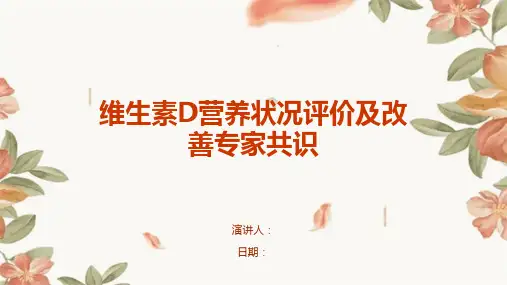

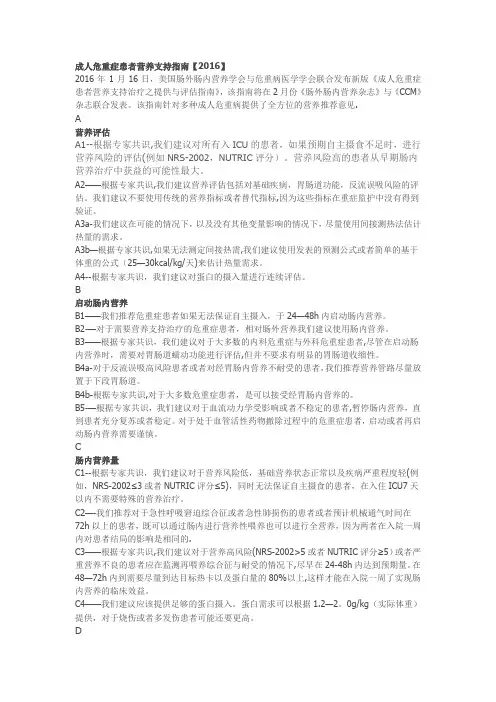
成人危重症患者营养支持指南【2016】2016年1月16日,美国肠外肠内营养学会与危重病医学学会联合发布新版《成人危重症患者营养支持治疗之提供与评估指南》,该指南将在2月份《肠外肠内营养杂志》与《CCM》杂志联合发表。
该指南针对多种成人危重病提供了全方位的营养推荐意见.A营养评估A1--根据专家共识,我们建议对所有入ICU的患者,如果预期自主摄食不足时,进行营养风险的评估(例如NRS-2002,NUTRIC评分)。
营养风险高的患者从早期肠内营养治疗中获益的可能性最大。
A2——根据专家共识,我们建议营养评估包括对基础疾病,胃肠道功能,反流误吸风险的评估。
我们建议不要使用传统的营养指标或者替代指标,因为这些指标在重症监护中没有得到验证。
A3a-我们建议在可能的情况下,以及没有其他变量影响的情况下,尽量使用间接测热法估计热量的需求。
A3b—根据专家共识,如果无法测定间接热需,我们建议使用发表的预测公式或者简单的基于体重的公式(25—30kcal/kg/天)来估计热量需求。
A4--根据专家共识,我们建议对蛋白的摄入量进行连续评估。
B启动肠内营养B1——我们推荐危重症患者如果无法保证自主摄入,于24—48h内启动肠内营养。
B2-—对于需要营养支持治疗的危重症患者,相对肠外营养我们建议使用肠内营养。
B3——根据专家共识,我们建议对于大多数的内科危重症与外科危重症患者,尽管在启动肠内营养时,需要对胃肠道蠕动功能进行评估,但并不要求有明显的胃肠道收缩性。
B4a-对于反流误吸高风险患者或者对经胃肠内营养不耐受的患者,我们推荐营养管路尽量放置于下段胃肠道。
B4b-根据专家共识,对于大多数危重症患者,是可以接受经胃肠内营养的。
B5-—根据专家共识,我们建议对于血流动力学受影响或者不稳定的患者,暂停肠内营养,直到患者充分复苏或者稳定。
对于处于血管活性药物撤除过程中的危重症患者,启动或者再启动肠内营养需要谨慎。
C肠内营养量C1--根据专家共识,我们建议对于营养风险低,基础营养状态正常以及疾病严重程度轻(例如,NRS-2002≤3或者NUTRIC评分≤5),同时无法保证自主摄食的患者,在入住ICU7天以内不需要特殊的营养治疗。
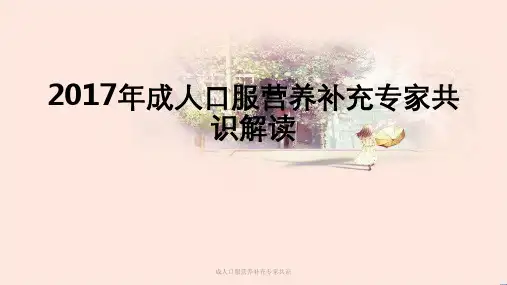


《成人口服营养补充专家共识》要点【引言】《成人口服营养补充专家共识》是由一群口服营养补充领域的专家共同制定的指导文件。
随着现代生活方式的改变,人们对于维持健康和预防疾病的需求日益增加。
本文将重点介绍《成人口服营养补充专家共识》的要点,旨在帮助读者更好地了解成人口服营养补充问题。
【要点】1.营养补充的重要性《成人口服营养补充专家共识》强调了成人口服营养补充的重要性。
在现代社会中,饮食不规律、营养摄入不足已成为常态,导致了营养不良和健康问题的出现。
正确的口服营养补充可以补充人体所需的营养素,提高免疫力,维持健康状态。
2.针对不同人群的口服营养补充方案《成人口服营养补充专家共识》根据不同人群的需求提出了相应的口服营养补充方案。
例如,对于长时间工作的白领人群,可以适当增加维生素B族和维生素C的摄入;对于中老年人来说,应重视钙和维生素D的摄入,以维持骨骼健康。
专家建议根据个体情况选择合适的口服营养补充品,并遵循正确的使用方法。
3.补充剂与饮食的关系尽管口服营养补充品在补充营养方面起到重要作用,但并不意味着可以完全替代饮食。
食物中的天然营养素更容易被身体吸收和利用。
《成人口服营养补充专家共识》强调,补充剂应与均衡饮食结合起来,从综合的角度满足人体营养需求。
4.注意剂量和安全性专家共识指出,成人口服营养补充品的使用应遵循剂量和安全性的原则。
过量摄入维生素和矿物质可能会引发问题,如维生素A中毒和矿物质不平衡等。
因此,在选择和使用时应遵循产品说明书的推荐剂量,并避免超过建议摄入量。
5.专家指导下的选择【结论】《成人口服营养补充专家共识》是口服营养补充领域的权威指导性文件。
它强调了营养补充的重要性,提供了针对不同人群的补充方案,并强调补充剂与饮食的结合、剂量和安全性的注意事项,同时鼓励在专家指导下选择和使用口服营养补充品。
通过遵循这些要点,人们可以更好地保持健康,提高生活质量。

成人家庭肠外营养中国专家共识成人家庭肠外营养中国专家共识近年来,随着社会发展和人们生活水平的提高,成人家庭肠外营养的需求逐渐增加。
在长期卧床、重病、手术后康复等情况下,肠道营养摄入不足常常成为一个难题,这时候肠外营养的作用便凸显出来。
为了解决成人家庭肠外营养相关的问题,中国专家们通过多次研讨和讨论,终于达成了如下共识。
一、适应症成人家庭肠外营养的适应症包括但不限于:机体无法正常进食,或者通过胃肠道摄入营养不足以满足需要的患者;暂时或永久性肠道功能丧失,无法使用胃肠道的患者;慢性肠炎、胃肠手术后恢复期等需要减少或避免经口摄入的患者。
二、配方成人家庭肠外营养的配方应尽可能满足患者的个体化需求。
一般而言,成人家庭肠外营养的基础配方应包含适当的能量、蛋白质、脂肪、碳水化合物、维生素、矿物质和微量元素。
根据患者具体情况,可以针对性地增加或减少某些成分,达到最佳效果。
三、肠外营养形式选择肠外营养形式选择包括:中心静脉营养(TPN)和周围静脉营养(PPN)。
根据患者实际情况,个体化选择不同的肠外营养形式。
一般而言,TPN适用于肠道无功能或短期不能使用的重症患者,而PPN适用于非重症患者或者需要辅助能量的患者。
四、管理与监测成人家庭肠外营养需要进行细致的管理和监测。
管理方面,要确保肠外营养配方的合理使用和输注速度的控制,避免出现过度或不足的情况。
监测方面,要定期检测患者的营养指标、电解质和肝肾功能等,及时发现并处理任何异常情况。
五、并发症与预防肠外营养过程中可能出现一些并发症,如感染、血栓、电解质紊乱等。
因此,预防并发症非常重要。
首先要保持良好的卫生习惯,避免感染;其次要合理控制输注速度,避免血栓形成;此外,要密切监测电解质平衡,及时进行补充。
六、退出肠外营养在一定条件下,患者可以退出肠外营养,通过正常饮食或者肠道轻度助餐逐渐恢复肠道功能。
这个过程需要有专业医生的指导,逐渐减少肠外营养的使用,并适时评估患者肠道功能的恢复情况。
《中国营养学会益⽣元与健康专家共识》概要及解读为了贯彻落实国务院《健康中国⾏动(2019-2030年)》和《国民营养计划(2017-2030年)》的重要措施,2021年5⽉15⽇,第七届全民营养周拉开了帷幕。
在全国营养科普⼤会上,益⽣菌益⽣元与健康分会发布了《中国营养学会益⽣元与健康专家共识》(以下简称“共识”),并由分会秘书长向雪松博⼠作了“共识”解读报告。
制定本“共识”的⽬的,是为消费者、营养师、临床医⽣、科研⼈员、⾷品企业和相关管理部门提供科学依据和建议,促进益⽣元产品的科学管理和合理应⽤,改善全民健康⽔平。
来⾃益⽣元研究和应⽤领域的专家,分别从益⽣元的定义与种类、特性、如何评估和证实⼀种物质是益⽣元、健康益处、消费者建议等五个⽅⾯,遵循科学和临床证据的原则,在⼤量⼯作的基础上,经反复讨论修改,最终制定了该科学共识。
本次发布的是“共识”的概要,详细内容将按计划陆续公布。
本次发布的“共识”概要全⽂如下:⼀、益⽣元的定义和种类定义根据全球益⽣元科学研究证据现状和我国益⽣元产业发展现状,本次共识的益⽣元定义特指⼀般不能被⼈体所消化吸收但可被⼈体微⽣物选择性利⽤,能够改善肠道微⽣物组成和/或活性从⽽益于⼈体健康的⾷物成分。
种类⽬前证据等级较⾼,得到公认的益⽣元⼏乎都属于碳⽔化合物,包括低聚果糖、菊粉、低聚半乳糖等。
还有些⾷物成分虽然已在通过体外和动物实验中进⾏了不同程度的研究,但在⼈体研究中却仍然很少。
随着益⽣元相关研究特别是临床研究的不断深⼊,越来越多的⾷物成分会得到认可,益⽣元的种类也会更加丰富。
⼆、益⽣元的特性1.物质属性不是微⽣物或者药物;可以进⾏化学定性和定量分析;通常是⼀种⾷物成分,不在⼩肠内消化吸收;可以是某类膳⾷纤维,但不等同于膳⾷纤维。
2.益⽣(健康)属性益⽣元依赖微⽣物代谢,可被⼈体微⽣物选择性利⽤⽽增进⼈体健康。
尽管许多特定物质也可被微⽣物分解利⽤,但如果这种作⽤不能给宿主带来健康益处,这种物质也不能被称为益⽣元。